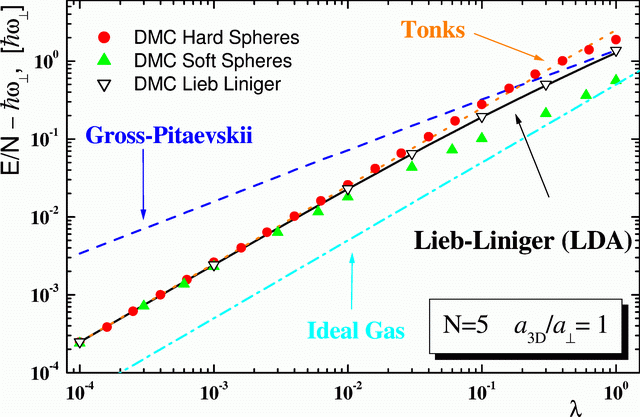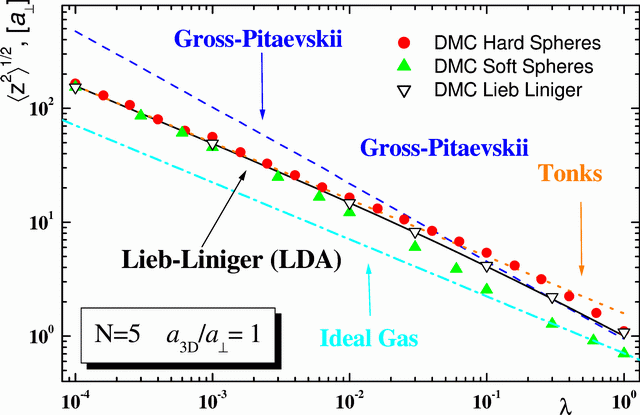



Next: Large system
Up: Results
Previous: Small system, small scattering
Contents
The results for
 are shown in Figs. 3.5-3.6. In this
case the HS and SS potential give significantly different results in the large
are shown in Figs. 3.5-3.6. In this
case the HS and SS potential give significantly different results in the large
 regime. For both potentials the mean-field description is inadequate. By
decreasing
regime. For both potentials the mean-field description is inadequate. By
decreasing  the HS system enters the Tonks-Girardeau regime before
approaching the LL results, whereas the SS system crosses from the ideal gas (IG)
regime to the Tonks-Girardeau regime. For this value of
the HS system enters the Tonks-Girardeau regime before
approaching the LL results, whereas the SS system crosses from the ideal gas (IG)
regime to the Tonks-Girardeau regime. For this value of
 the DMC results
with the Hamiltonian (3.8) coincide exactly with the ones of the LL equation
of state in LDA due to the large coupling constant.
the DMC results
with the Hamiltonian (3.8) coincide exactly with the ones of the LL equation
of state in LDA due to the large coupling constant.
Figure 3.5:
Energy per particle as a function of  . Dashed line:
GP equation (3.3), solid line: LL equation of states in LDA, dotted line:
TG gas, dot-dashed line: non-interacting gas.
. Dashed line:
GP equation (3.3), solid line: LL equation of states in LDA, dotted line:
TG gas, dot-dashed line: non-interacting gas.
|
|
Figure 3.6:
Mean square radius along  as a function of
as a function of  .
Dashed line: GP equation (3.3), solid line: LL equation of states in LDA,
dotted line: TG gas, dot-dashed line: non-interacting gas.
.
Dashed line: GP equation (3.3), solid line: LL equation of states in LDA,
dotted line: TG gas, dot-dashed line: non-interacting gas.
|
|




Next: Large system
Up: Results
Previous: Small system, small scattering
Contents
G.E. Astrakharchik
15-th of December 2004
![]() are shown in Figs. 3.5-3.6. In this
case the HS and SS potential give significantly different results in the large
are shown in Figs. 3.5-3.6. In this
case the HS and SS potential give significantly different results in the large
![]() regime. For both potentials the mean-field description is inadequate. By
decreasing
regime. For both potentials the mean-field description is inadequate. By
decreasing ![]() the HS system enters the Tonks-Girardeau regime before
approaching the LL results, whereas the SS system crosses from the ideal gas (IG)
regime to the Tonks-Girardeau regime. For this value of
the HS system enters the Tonks-Girardeau regime before
approaching the LL results, whereas the SS system crosses from the ideal gas (IG)
regime to the Tonks-Girardeau regime. For this value of
![]() the DMC results
with the Hamiltonian (3.8) coincide exactly with the ones of the LL equation
of state in LDA due to the large coupling constant.
the DMC results
with the Hamiltonian (3.8) coincide exactly with the ones of the LL equation
of state in LDA due to the large coupling constant.

